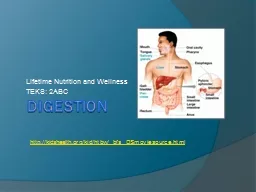

TEKS 2ABC httpkidshealthorgkidhtbwbfsDSmoviesourcehtml Digestion Before your body can use the nutrients in the food you eat it must go through digestion Then nutrients must go through absorption ID: 777752
Download The PPT/PDF document "Digestion Lifetime Nutrition and Wellnes..." is the property of its rightful owner. Permission is granted to download and print the materials on this web site for personal, non-commercial use only, and to display it on your personal computer provided you do not modify the materials and that you retain all copyright notices contained in the materials. By downloading content from our website, you accept the terms of this agreement.
Slide1
Digestion
Lifetime Nutrition and WellnessTEKS: 2ABC
http://kidshealth.org/kid/htbw/_bfs_DSmoviesource.html
Slide2Digestion
Before your body can use the nutrients in the food you eat, it must go through digestion.Then nutrients must go through absorption.Digestion
-the bodily process of breaking food down into simpler compounds the body can useAbsorption-the process of taking in nutrients and making them part of the body
Slide3The Digestive Tract
The digestive or gastrointestinal tract is a tube about 30 feet long.It extends from the mouth to the anus.
Contains the esophagus, stomach, small intestine, and large intestineThey work together to both mechanically and chemically help the body use food.
Slide4The Digestion Process
The body breaks down complex molecules from the food into simple, soluble materials.They pass through the digestive tract into the blood and lymph systems.Vitamins and minerals undergo very little chemical change during digestion.
Fats, proteins, and carbs undergo many changes.
Slide5The Mechanical Phase
Begins in the mouth, the teeth chew the food and break it down into small piecesContractions of the muscular walls of the digestive tract carry on the mechanical action.
The contractions mix food particles and break them into smaller piecesWaves of contractions knows as peristalsis, the muscles push food through the digestive tract
Emotions can slow down or speed up the process
Slide6The Chemical Phase
Begins in the mouthAs you chew, food is mixed with
saliva. (mucus and enzyme containing liquid)It moistens food particles, helping them move down the esophagus into the stomach.Saliva also begins
to break down starches.
Slide7The Chemical Phase
In the stomach, gastric juices containing hydrochloric acid and several enzymes are secreted.
These juices break down the food more.Ordinary meal usually leaves the stomach in about 2 to 3 hoursCarbs leave the stomach first, proteins second, fats last
You will feel hungry sooner after a meal high in
carbs
Slide8Chemical continued…
Then the semi-liquid food leaves the stomach and enters the small intestineIntestinal juices, pancreatic juices, and bile act on the food
Digestive enzymes help break down the carbs, proteins, and fats into simple substances the body can absorb and use.
Once digestion is complete absorption can take place.
Slide9Large Intestines
Indigestible residues, bile pigments, other wastes, and water travel from the small intestine to the large intestine.The large intestine acts as a reservoir, or storage area.
Eventually the body will excrete these materials.
Slide10Absorption Process
The body can absorb water, ethyl alcohol and simple sugars directly from the stomach.They pass through the stomach walls into the bloodstream.
However, most absorption takes place in the small intestines.
Slide11Absorption Process
Millions of hair like fingers called villi line the small intestines.The villi
increase the absorptive surface of the small intestine by more than 600%.Each villus contains a lymph vessel surrounded by a network of capillaries.Nutrients absorbed by the capillaries pass into the portal vein and travel directly to the
liver
.
Slide12Metabolism
The chemical processes that take place in the cells after the body absorbs nutrientsEnzymes cause nearly all metabolic reactions.The body uses nutrients to replace substances used for growth and to carry out body processes.
Slide13Metabolism
The body breaks down some nutrients into simpler substances to release energy.The body uses part of this energy to carry out metabolic reactions.It converts the rest into heat.
The body converts all carbs into glucose for use as an energy source.If they are not needed for immediate energy, they can be converted to glycogen or in the body as fat tissue.
Slide14Metabolism
During fat metabolism, fatty acid chains are shortened. The body uses most fat for fuel.The body can use amino acids from protein metabolism for cell maintenance or cell growth.It can also use amino acids to make enzymes, antibodies, nonessential amino acids, and as an energy source.
Slide15http://kidshealth.org/parent/general/body_basics/digestive.html
http://www.neok12.com/php/watch.php?v=zX43417c4d68676e7352667b&t=Digestive-System